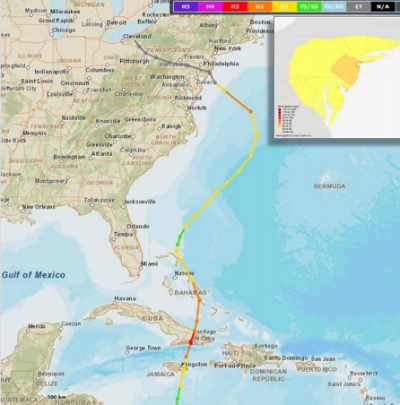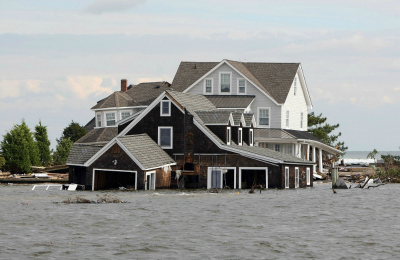

Karen Clark & Company (KCC), independent experts in catastrophe risk, catastrophe models and catastrophe risk management, issued a report in conjunction with the one-year anniversary of Superstorm Sandy. One of the issues the report looks at is why the storm caused so much flooding damage along the coast.
There are several meteorological parameters that drive the peak storm surge in a hurricane, and generally these are the same factors that cause high wind speeds. But while there is a correlation between the wind and storm surge intensities, additional factors influence the level and extent of the storm surge.
The Karen Clark & Company report notes that one very important factor is the storm track. A storm that makes landfall perpendicular to the coast will produce a higher storm surge than the same storm moving parallel to the coast or coming ashore at an oblique angle.
While Sandy was not an intense storm as measured by wind speed, the report notes, it was a very large storm that curved to the west and made landfall at a right angle to the coastline. To the right of the storm track the New York Bight was perfectly situated to produce a funneling effect further enhancing the surge heights. Had the storm followed a more typical track parallel to the coast, the storm surge would have been much less, particularly in New Jersey, Staten Island and Queens.
Large storms also create more surge than smaller storms because the winds in a larger storm will push on a larger area of the ocean, and the storm surge will affect more of the coastline.
The report says that, for example, Katrina was a large storm and caused higher surge than more intense storms in the Gulf, including Camille (1969) and Charley (2004). Other important factors influencing storm surge are coastal bathymetry, astronomical tide, and the presence of inlets, bays and rivers.
The report also notes that for sections of the coast where the continental shelf is relatively wide and shallow, the storm surge will build up much more as the hurricane moves ashore.
The continental shelf is relatively wide off the coasts of New Jersey and New York and slopes down gradually. The same hurricane will cause more surge here than in areas where the continental shelf falls off more steeply, such as Southeast Florida, the report notes.
The wind circulation in a hurricane blows on the ocean surface and produces a vertical circulation in the ocean. Out in the ocean, in deep water, there’s nothing to disturb this circulation and there is little indication of storm surge. However, when the hurricane moves into the shallower waters off the coast, the vertical circulation is disrupted—it can no longer go down so it pushes up and inland.
Additionally, the report says, in coastal areas where the astronomical tide heights vary significantly between low and high tide, the combined water level can be elevated if the storm occurs at high tide. The difference between low and high tide along the New Jersey and New York coastlines is eight feet. This is a relatively large range and further enhances the storm surge vulnerability in this region.

Finally, in areas where there are significant bays, rivers and inlets, the storm surge potential is greater because as a volume of water is funneled into a narrower area, the water heights will increase, the report says.
In summary, the primary factors influencing the level and extent of the storm surge from a hurricane are: storm intensity and peak winds; the size of the storm; the angle of the track relative to the coastline; the coastal bathymetry; presence of inlets, bays or rivers; and local topography.
Commentary on Climate Change
Among other issues the Karen Clark & Company report looks at is whether there was any link between climate change and Superstorm Sandy.
The report says that the current scientific consensus according to the fifth assessment report of the Intergovernmental Panel on Climate Change (IPCC) is that climate change is not likely to produce more tropical cyclones—in fact, frequency may decrease—but rather more intense storms. Superstorm Sandy was not intense as measured by wind speed, and most of the damage in the U.S. occurred because of its large size and track angle relative to the coast.
The report notes that the track of Sandy was unusual primarily because of the position of the jet stream. Some scientists have speculated that climate change is weakening the jet stream and increasing its tendency to “meander” into different positions. The report also says there are theories that the melting sea ice is affecting the jet stream.
The report also discusses findings from Jennifer Francis, climate scientist at Rutgers University, who says that as the Artic warms and the temperature difference between the poles and the lower latitudes decreases, the jet stream slows down, and the kinks in it last longer.
Francis’ research suggests that the northward swings in the jet stream — like the one that existed at the time of Sandy — are happening more frequently now, and a month before Sandy, the Arctic sea-ice extent reached a record low.
But the report says Francis, along with other scientists, agrees that a direct link can’t be made between the record sea-ice low and Sandy’s track. In general, there is no conclusive evidence to support these theories.
What is conclusive is that sea level rise contributed to the significant storm surge damage from Sandy, the report says. For example, the sea level around lower Manhattan has increased by nearly one foot over the past 100 years, adding one foot to what the storm surge would have been. The report says scientists can agree that the flooding damage from all types of storms will be exacerbated as the sea levels continue to rise.
Source: Karen Clark & Company